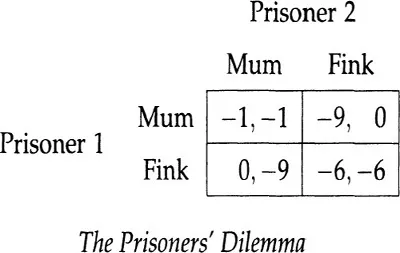![]()
Chapter 1
Static Games of Complete Information
In this chapter we consider games of the following simple form: first the players simultaneously choose actions; then the players receive payoffs that depend on the combination of actions just chosen. Within the class of such static (or simultaneous-move) games, we restrict attention to games of complete information. That is, each player’s payoff function (the function that determines the player’s payoff from the combination of actions chosen by the players) is common knowledge among all the players. We consider dynamic (or sequential-move) games in Chapters 2 and 4, and games of incomplete information (games in which some player is uncertain about another player’s payoff function—as in an auction where each bidder’s willingness to pay for the good being sold is unknown to the other bidders) in Chapters 3 and 4.
In Section 1.1 we take a first pass at the two basic issues in game theory: how to describe a game and how to solve the resulting game-theoretic problem. We develop the tools we will use in analyzing static games of complete information, and also the foundations of the theory we will use to analyze richer games in later chapters. We define the normal-form representation of a game and the notion of a strictly dominated strategy. We show that some games can be solved by applying the idea that rational players do not play strictly dominated strategies, but also that in other games this approach produces a very imprecise prediction about the play of the game (sometimes as imprecise as “anything could happen"). We then motivate and define Nash equilibrium—a solution concept that produces much tighter predictions in a very broad class of games.
In Section 1.2 we analyze four applications, using the tools developed in the previous section: Cournot’s (1838) model of imperfect competition, Bertrand’s (1883) model of imperfect competition, Farber’s (1980) model of final-offer arbitration, and the problem of the commons (discussed by Hume [1739] and others). In each application we first translate an informal statement of the problem into a normal-form representation of the game and then solve for the game’s Nash equilibrium. (Each of these applications has a unique Nash equilibrium, but we discuss examples in which this is not true.)
In Section 1.3 we return to theory. We first define the notion of a mixed strategy, which we will interpret in terms of one player’s uncertainty about what another player will do. We then state and discuss Nash’s (1950) Theorem, which guarantees that a Nash equilibrium (possibly involving mixed strategies) exists in a broad class of games. Since we present first basic theory in Section 1.1, then applications in Section 1.2, and finally more theory in Section 1.3, it should be apparent that mastering the additional theory in Section 1.3 is not a prerequisite for understanding the applications in Section 1.2. On the other hand, the ideas of a mixed strategy and the existence of equilibrium do appear (occasionally) in later chapters.
This and each subsequent chapter concludes with problems, suggestions for further reading, and references.
1.1 Basic Theory: Normal-Form Games and Nash Equilibrium
1.1.A Normal-Form Representation of Games
In the normal-form representation of a game, each player simultaneously chooses a strategy, and the combination of strategies chosen by the players determines a payoff for each player. We illustrate the normal-form representation with a classic example —The Prisoners’ Dilemma. Two suspects are arrested and charged with a crime. The police lack sufficient evidence to convict the suspects, unless at least one confesses. The police hold the suspects in separate cells and explain the consequences that will follow from the actions they could take. If neither confesses then both will be convicted of a minor offense and sentenced to one month in jail. If both confess then both will be sentenced to jail for six months. Finally, if one confesses but the other does not, then the confessor will be released immediately but the other will be sentenced to nine months in jail—six for the crime and a further three for obstructing justice.
The prisoners’ problem can be represented in the accompanying bi-matrix. (Like a matrix, a bi-matrix can have an arbitrary number or rows and columns; “bi" refers to the fact that, in a two-player game, there are two numbers in each cell—the payoffs to the two players.)
In this game, each player has two strategies available: confess (or fink) and not confess (or be mum). The payoffs to the two players when a particular pair of strategies is chosen are given in the appropriate cell of the bi-matrix. By convention, the payoff to the so-called row player (here, Prisoner 1) is the first payoff given, followed by the payoff to the column player (here, Prisoner 2). Thus, if Prisoner 1 chooses Mum and Prisoner 2 chooses Fink, for example, then Prisoner 1 receives the payoff −9 (representing nine months in jail) and Prisoner 2 receives the payoff 0 (representing immediate release).
We now turn to the general case. The normal-form representation of a game specifies: (1) the players in the game, (2) the strategies available to each player, and (3) the payoff received by each player for each combination of strategies that could be chosen by the players. We will often discuss an n-player game in which the players are numbered from 1 to n and an arbitrary player is called player i. Let Si denote the set of strategies available to player i (called I’s strategy space), and let si denote an arbitrary member of this set. (We will occasionally write si ε Si to indicate that the strategy si is a member of the set of strategies Si.) Let (s1, …, sn) denote a combination of strategies, one for each player, and let ui denote player i’S payoff function: ui(s1, …, sn) is the payoff to player i if...

